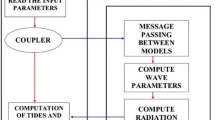Abstract
Super typhoon Durian struck the central Philippines on November 30, 2006 and southern coast of Vietnam on December 5, 2006. The reported maximum wind exceeded 250 km/h, and the central pressure was 904 hPa during the peak of the system. The typhoon brought colossal damage, both in terms of lives and in terms of properties to the Philippines and Vietnam while Thailand and Malaysia were slightly affected. The energy from the high-velocity wind and central pressure drop resulted in the generation of storm surges along the coastal region of the Philippines including its surrounding islands as well as parts of southern Vietnam. In this paper, a numerical 2D model is used to study the oceanic response to the atmospheric forcing by 2006 super typhoon Durian in the coastal regions of the Philippines and Vietnam. The initial study of this model aims to provide some useful insights before it could be used as a coastal disaster prediction system in the region of South China Sea (SCS). The atmospheric forcing for the 2D model, which includes the pressure gradient and the wind field, is generated by an empirical asymmetrical storm model. The simulated results of storm surges due to typhoon Durian at two locations lie in the range of observed data/estimates published by the Joint Typhoon Warning Centre (JTWC).












Similar content being viewed by others
References
As-Salek JA, Yasuda T (1995) Comparison study of the storm surge models proposed for Bangladesh: last development and research needs. J Wind Eng Ind Aerodynamics, Elsevier 54(55):595–610
Chang CP (2006) Interaction of synoptic systems over the equatorial south China Sea during the winter monsoon. International symposium on winter monsoon experiment (WMONEX 25 +). April 7–10, 2006. Kuala Lumpur, Malaysia, pp 45–53
Chang CP, Harr PA, Chen HJ (2005) Synoptic disturbances over the equatorial south China sea and western maritime continent during boreal winter. Mon Weather Rev 133:489–503
Das PK (1972) A prediction model for storm surge in the Bay of Bengal. Nature 239:211–213
De Vries H, Breton M, De Mulder T, Krestenitis Y, Ozer J, Ruddick K, Salomon JC, Voorrips A (1994) A Comparison of 2D storm surge models applied to three shallow European seas. J Env Softw, Elsevier 10:23–42
Dudhia J, Gill D, Manning K, Wei W, Bruyere C, Kelly S, Lackey K, et al. (2005) MM5 version 3 tutorial presentations (NCAR,MMM) (Jan 2005). Available: http://www.mmm.ucar.edu/mm5/On-Line-Tutorial/presentations/tut-presentations.html
Durran DR (1998) Numerical methods for wave equation in geophysical fluid dynamics. Springer-Verlag, New York, pp 414–419
Engineers VatnaskilConsulting (1998) User’s guide for AQUASEA: tidal flow in estuaries and coastal areas lake circulation transport modelling. Reykjavik, Iceland
Gill AE (1984) On the behaviour of internal waves in the wakes of storms. J Phys Oceanogr 25:1218–1251
Jelesnianski CP, Chen J, Shaffer WA (1992) SLOSH: sea, lake, and overland surges from hurricanes, noaa technical report NWS 48. National Weather Service, Silver Spring, Maryland, p 71
Johns B, Dube SK, Mohanty UC, Sinha PC (1981) Numerical simulation of the surge generated by the 1977 Andhra cyclone. Q J R Meteorol Soc 107:919–934
Johns B, Sinha PC, Dube SK, Mohanty UC, Rao AD (1983) Simulation of storm surges using a three dimensional numerical model: An application to the 1977 Andhra cyclone. Q J R Meteorol Soc 109:211–224
Johns B, Rao AD, Dube SK, Sinha PC (1985) Numerical modeling of tide-surge interaction in the Bay of Bengal. Philos Trans R Soc Lond A 313:507–535
JTWC (2007). JTWC Western North Pacific best track data. http://metocph.nmci.navy.mil/jtwc/best_tracks/wpindex.html, 26 Feb 2009
Koh HL, Teh SY, Liu LF, Izani AMI, Lee HL et al. (2008) Simulation of Andaman 2004 Tsunami for assessing impact on Malaysia. J Asian Earth Sci doi:10.1016/j.jseaes.2008.09.008
Kowalik Z, Murty TS (1993) Numerical modeling of ocean dynamics. World Scientific, Singapore
Liew JN, Tangang FT (2007) Barotropic response of sunda shelf to an axisymmetric moving vortex. Proceedings in 2nd Regional Conference on Ecological and Environmental Modeling, Universiti Sains Malaysia, Penang, Malaysia
Mellor G (2004) User’s guide for a three-dimensional primitive equation. Numerical Ocean Model, Princeton University, New Jersey, pp 1–56
MM5 community model (2006) Available: http://www.mmm.ucar.edu/mm5/, 1 Sep 2006
NGDC (2008) NOAA satellite and information services: bathymetry, topography and relief. United States Department of Commerce/National Oceanic and Atmospheric Administration/NOAA’s National Environmental Satellite, Data, & Information Service/National Geophysical Data Center (NGDC) http://www.ngdc.noaa.gov/mgg/gdas/gd_designagrid.html
O’Brien JJ, Reid RO (1967) The nonlinear response of a two-layer, Baroclinic ocean to a stationary, axially symmetric hurricane. Part 1: upwelling induced by momentum transfer. Journal of atmospheric science 24:197–207
Ramming HG, Kowalik Z (1980) Numerical modeling of marine hydrodynamics: applications to dynamic physical processes. Elsevier, New York
Tang YM, Grimshaw R (1996) Radiation boundary conditions in barotropic coastal ocean numerical models. J Comput Phys 123:96–110
Tang MY, Grimshaw R, Sanderson B, Holland G (1996) A numerical study of storm surge and tides, with application to the North Queensland coast. J Phys Oceanogr 26:2700–2711
Tang CL, Gui Q, DeTracey BM (1998) Barotropic response of the labrador/newfoundland shelf to a moving storm. J Phys Oceanogr 28:1152–1172
Wijeratne EMS, Rydberg L (2007) Modelling and observations of tidal wave propagation, circulation and residence times in Puttalam Lagoon, Sri Lanka. J Estuar Coast Shelf Sci 74:697–708
Author information
Authors and Affiliations
Corresponding author
Rights and permissions
About this article
Cite this article
Loy, K.C., Sinha, P.C., Liew, J. et al. Modeling storm surges associated with super typhoon durian in South China Sea. Nat Hazards 70, 23–37 (2014). https://doi.org/10.1007/s11069-010-9674-7
Received:
Accepted:
Published:
Issue Date:
DOI: https://doi.org/10.1007/s11069-010-9674-7




